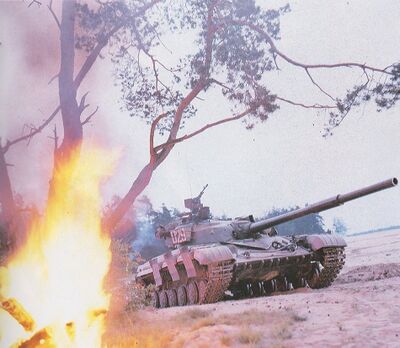Seven Day War
| Seven Day War | |||||||||
|---|---|---|---|---|---|---|---|---|---|
| Part of Granika Border War | |||||||||
 Syaran Manticore Main Battle Tank in Zemplen | |||||||||
| |||||||||
| Belligerents | |||||||||
|
|
| ||||||||
| Commanders and leaders | |||||||||
|
|
| ||||||||
| Units involved | |||||||||
|
|
| ||||||||
| Strength | |||||||||
|
|
| ||||||||
| Casualties and losses | |||||||||
|
|
| ||||||||
The Seven Day War (Syaran: Седумдневна војна, Sedumdnevna vojna, Ruvelkan: Üïṹṵiũīḻ Üíǔīṷḯ, Hétnapos háború, Karvelebi: შვიდი დღის ომი shvidi dghis omi) also known as the Zemplen Uprising, the 1969 War, the Solstice War, and prior to 2008 the Zemplen War, was fought by the Republic of Syara against the separatist group SDM and Ruvelka.
The root of the war lay in the long standing territorial dispute over the border region of Zemplen, which Syara had occupied in 1916 during the Ruvelkan Civil War. Although Ruvelka had signed the Treaty of Debrecen at the end of the Siduri War the Principality continued to oppose Syaran control of Zemplen, which they viewed as a significant security risk to Ruvelkan sovereignty following the invasion of Ruvelka in 1934. Beginning in the early 1960s Ruvelka began cooperating with the SDM separatist group, which was violently pursuing indepenence from Syara, in an effort to expel Syara from Zemplen. This resulted in the Granika Border War, a largely asymmetrical and low intensity conflict defined by border incursions and raids rather than overt confrontation.
Following the election of Chancellor Laura Gulyás in August 1968, the SDM under the leadership of Alexei Khurtsilava began pushing for a large scale uprising across Zemplen with support from Ruvelka. Although Gulyás was reluctant to risk confrontation with Syara, Ruvelka eventually agreed to support the effort after Khurtsilava and the SDM's leadership insisted that a popular uprising would be succesful. The uprising, which was codenamed "დიდი გამოღვიძება" (Didi Gamoghvidzeba, or "Great Awakening") would involve SDM militia seizing control of vital infrastructure and major urban areas while declaring independence from Syara, after which Debrecen would recognize Zemplen's sovereignty and deploy military forces to guarantee Zemplen as a Ruvelkan protectorate. It was then hoped that international sympathy for the Karvelebi, coupled with Syara's continued post-Siduri War diplomatic isolation, would convince Zovahr to back down and accept Ruvelkan control of Zemplen.
Beginning in early 1969 the SDM, with support from the Imperial Armed Forces of Ruvelka, began smuggling large amounts of weaponry and ammunition into Zemplen. While this was ongoing Ruvelkan special forces repeatedly launched cross border raids to test Syaran responsiveness and guage the effectiveness of Syaran early warning capabilities. The date of the uprising was planned for the summer solstice, a major holiday in Syara's national religion of Zobethos in the hope that many Syaran soldiers and officials would be away from their posts.
At dawn on 21 June the SDM initiated the uprising by seizing control of government buildings. At 0930 Khurtsilava announced by radio the creation of the Zemplen People's Republic from Sopron, and around noon the Ruvelkan Government announced its recognition of independent Zemplen and Ruvelkan troops began entering the region. The SDM's expectation of a mass popular uprising however proved overly optimistic, and the reaction from most of Zemplen's populace was mixed. President of Syara Marija Kostova declared the uprising an act of insurrection and ordered the Army of the Syaran Republic to restore legal rule over Zemplen. On 22 June Syara began massing 80,000 troops along the border while the Syaran Army Air Corps struck SDM and Ruvelkan positions. On the 23rd the Syarans entered Zemplen and engaged SDM militia and Ruvelkan forces, the latter of which had believed SDM estimates of popular support and were not expecting stiff Syaran resistance. By the 24th the Ruvelkans had ceded control of the air to Syara, and Sopron was surrounded by the Syarans on the 25th. On 26 June the Syarans repulsed the remaining Ruvelkan units from Zemplen, after which Ruvelka requested a ceasefire and rescinded its recognition of Zemplen's independence. Sopron fell to the Syarans the next day and Khurtsilava surrendered, after which the remaining SDM forces dissolved and the conflict ended.
The aftermath of the war had significant political and social impact on the involved parties. The failure of the uprising effectively ended the working relationship between the SDM and Ruvelka, both of which accused one another of falling short of expectations. Khurtsilava, who was captured by the Syarans, was executed in 1970. The SDM subsequently labeled him a martyr and began a new campaign of targetted violence against Syara, which increasingly isolated it from international support. The resounding defeat Ruvelka's armed forces had suffered convinced the Principality of its inability to match Syara conventionally and began shifting its doctrinal approach to increasingly asymmetrical measures. Politically the government of Laura Gulyás narrowly survived a motion of no confidence, although it managed to secure a ceasefire with Syara tensions between the two remained high and fighting along the border continued. In Syara the victory proved bittersweet; President Kostova's acceptance of peace after a strong performance by the Syaran military outraged Syaran nationalists, especially those among the increasingly vibrant Warden movement.